
The Importance of Returning to a Proper
Appreciation of Blavatsky-Masters Theosophy
Robert Kitto

Geoffrey A. Farthing (1909-2004)
“…Among the commandments of
Tsongkhapa there is one that enjoins the Rahats
(Arhats) to make an attempt to enlighten the world,
including the ‘white barbarians’, every century, at
a certain specified period of the cycle.”
[Helena Blavatsky, in “Collected
Writings”, TPH, Volume XIV, p. 431]
It is almost a cliché to say that one of the greatest challenges facing any serious student of Theosophy is the futile attempt to reconcile the teachings of H.P. Blavatsky and her Adept Teachers, in the great outpouring of occult knowledge that occurred during the latter portion of her lifetime, and that which passed as Theosophy in the early part of the twentieth century, and now referred to as neo-, or pseudo-Theosophy. [1]
Many Theosophists are content to follow the revisions and the re-statement of Theosophy that followed Blavatsky’s death, as this re-statement forms a substantial corpus of material belonging to the principle Theosophical Society – that having its international headquarters at Adyar. Geoffrey Farthing, an active English member of the Adyar Society until his death in 2004, and one of Theosophy’s finest minds was not content that this was so, and became one of the greatest exponents of Blavatsky-Masters rendition of Theosophy. Many believe the distinction to be relatively unimportant, being all “Theosophy”, but he argued forcibly, and consistently, that this is not so.
Geoffrey Farthing (1909-2004) was concerned that the original point and purpose of the Theosophical Society, and the efforts of the Adept Teachers who had made its formation possible, had been lost in the years that followed the Blavatsky’s death, and that a significant part of the substance and detail of the teachings had become distorted. His writings, over nearly forty years, primarily aim to accurately present Blavatsky’s work in a form suited to the modern reader, and in addition, a significant number of articles and letters take a critical and sometimes controversial look, at the Society itself. The matter is as relevant today, as it ever was, for the “original point and purpose” that he sought so tenaciously to re-establish within the Society was that the Blavatsky-Masters teachings were the means “to help mankind along its proper evolutionary path”. Whether one agrees, or not, and he recognised that it is for individuals to arrive at their own views, he argued that the Society, which had, after all, been entrusted with this knowledge, should primarily present it in a clear and accessible way, and distinct from later personally derived and speculative additions.
In 1969 Geoffrey Farthing wrote “the past few decades, for one reason or another, the Society, in my view, has lost its identity. It has become buried in accretions.” These words, in an article entitled “What is the Theosophical Society?” [2] opened a new stage in a debate that has challenged (and fractured) the Society ever since Blavatsky’s death in 1891. Geoffrey, as probably the late twentieth century’s principle and foremost exponent of Blavatsky-Theosophy, took up the challenge of reinstating the primacy of her teachings in a well argued and tenacious, though controversial, debate which continues to this day.
After joining The Theosophical Society in 1948, and having originally studied the writings of C.W. Leadbeater, and Annie Besant – that which had initially been offered to him (thus illustrating the problem he addresses) – he moved to studies of Blavatsky’s extensive work, and also “The Mahatma Letters to A.P. Sinnett” whereby he first realised the inconsistency between Besant/Leadbeater writings and that which they had been entrusted with. [3] Subsequently he wrote;
“I could not believe that well-informed and gifted people like Leadbeater and Besant had ‘got it wrong’. Somehow or another fault lay in me and I wrestled over this problem for perhaps 2 years. During this time I studied in detail the classification of man’s principles from both points of view (e.g. Blavatsky in The Key to Theosophy) and tried hard to reconcile them, but they are not reconcilable. Eventually of course this led to my publishing the booklet THE ETHERIC DOUBLE? ” [4]
Having written “Theosophy – What it All About?” (1967) and “When we Die” (1972), a comprehensive exposition of the after-death states, accurately based on “The Mahatma Letters to A.P. Sinnett” (and at considerable variance to the clairvoyant conjecture of Leadbeater), he served as National President of the Theosophical Society in England (1969-72).
Without the support of the then neo-Theosophist majority in England, he was unable to continue his Presidency, but Christmas Humphreys, to whom serious students of esotericism have gratitude for his having collaborated with Elizabeth Preston in producing “An Abridgement of The Secret Doctrine” (Blavatsky’s magnum opus), and a (third and definitive) edition of “The Mahatma Letters to A.P. Sinnett”, joined with him in the founding of The Blavatsky Trust (1974). Christmas Humphreys [5] who was equally determined to do all he could to preserve Blavatsky’s teachings “as given” wrote:
“… I supported that tower of strength and knowledge, Mr. Geoffrey Farthing … in the foundation of The Blavatsky Trust, in an attempt to wean Lodges of the parent body from pseudo-Theosophy, and to give them at least a list of books which contain the original teaching. Whether an individual finds the vast cycle of wisdom offered to the world under that title to be true is for that student to decide, but at least let it be clear what is and what is not ‘Theosophy’.” [6]
Geoffrey’s contention that the H. P. Blavatsky-Masters teachings “constitute the authentic revelation of Theosophy” is a view he recognised to be widely resented by the majority within the Society. [7] Quite often, the abstruse writings of Blavatsky are not the first to be turned to for spiritual enquiry, and the notions derived – perhaps painstakingly – from the miscellany of other sources are probably not easily relinquished. Within the Adyar Society an attempt had been made – most likely well meant – to re-present Blavatsky’s partially abstract concepts and complex disjointed prose, with a systemised and detailed metaphysical dogma. At best, this supplanted the “root-substance” from which spiritual intelligence-intuition can arise with that of intellect, but it also introduced error, inconsistency and even fanciful imaginings.
Ernest Wood who worked closely at Adyar, in an editorial capacity with C.W. Leadbeater, later writing in his autobiography “Is This Theosophy … ?” [8] describes the use of imagination in deriving some of the detail of Chakras for publication. This later material has been the basis for many aspects of new-age spirituality. Such a view inevitably has its critics, and “Back to Blavatsky” became a derisive taunt, though Geoffrey was quick to challenge this illogicality:
“Such an expression could only be uttered seriously by those fundamentally ignorant of what, through her [H.P. Blavatsky’s] agency, the Masters gave us. It is like electrical engineers taunting each other with going back to Faraday, or atomic scientists back to Planck or Rutherford, or mathematicians back to Newton or Einstein. There is no such thing in matters of knowledge as going back to anyone.” [9]
Over the next few decades Geoffrey dedicated himself to much Theosophical work, writing a number of books, documentary films, and many articles. He returned to promoting the restoration of the Theosophical Society itself in an article “The Theosophical Society and Its Future” [10] , which looked at characters such as Annie Besant, C.W. Leadbeater, and Jiddu Krishnamurti through whom the drama of early twentieth century Theosophy had been so dramatically, and damagingly played out. Because of the suggestions for change contained therein it became known as the “Manifesto”.
A few years before his death he wrote, in a letter to his friends throughout the world;
“After fifty years of fairly intense study I have come to the conclusion that the original outpouring of occult knowledge from the Masters, to the extent that they then gave it out, was a unique world event. It has not been properly appreciated as such.” [11]
The importance of returning to a proper appreciation and understanding of Blavatsky-Masters Theosophy, and recognising it as a unique event – for the benefit of humanity – is being increasingly understood. Only by the transformational effect of the original outpouring having successfully run its course, it is argued, can we reasonably expect further Adept teachings. This was the keystone of Geoffrey’s life and work, and there is a deep spiritual altruism at its heart.
Throughout his life, he wrote over 150 Articles, 120 letters for publication, 4 documentary film scripts, gave hundreds of lectures, taught, and published nearly 20 books and booklets, together with a large collection of valuable audio material. Geoffrey’s work continues to have relevance, and through its efforts the Trust places Theosophy before those wishing to understand esoteric philosophy in a form stripped of the inconsistent speculations of the twentieth century.
The Trust, www.blavatskytrust.org.uk , remains active, and in addition to posthumously publishing and promoting Geoffrey’s work, is an educational charity funding a successful International Chair in Western Esotericism (including a Theosophy module), at the prestigious University of Exeter, UK. The Trust has recently (2009) re-published Geoffrey’s “Deity, Cosmos and Man” (which is also online), re-published 4 video documentary films as DVD, and in August posthumously published Geoffrey’s “The Kabalah and Theosophy”.
There are numerous – yet unpublished – pieces that are intended for eventual publication, including a volume entitled “The Word” (left unfinished). At the time of his death he was engaged in researching and writing “Compare & Contrast” (a provisional title) upon his predominant theme – the comparison of true Theosophy with that of its unintended neo- pseudo- progeny.
NOTES:
[1] Comparisons are made in “Theosophy vs. Neo-Theosophy”, Margaret Thomas, Isis Books, 1995. (An online version of an earlier edition is available.)
[2] Available online.
[3] In “The Theosophical Society and its Future” published in The High Country Theosophist, May 1997 Geoffrey wrote; “The divergence of the two systems became clearly apparent with the publication of the Mahatma Letters in 1924/5. It was unfortunate that, for a number of reasons, their publication had been delayed till then.”
[4] From “Life And Work of Geoffrey Farthing – The Autobiographic Testimony Of a Leading Theosophist”, by Carlos Cardoso Aveline. The text is available at www.TheosophyOnline.com and its associated websites. As to the article “The Etheric Double”, it can be found at www.blavatskytrust.org.uk/html/booklets/etheric_double.htm .
[5] Christmas Humphreys (and the Lodge of which he was President) seceded from The Theosophical Society in 1926, a divisive time within the Society, and this eventually formed the Buddhist Society of Great Britain.
[6] Christmas Humphrey’s autobiography “Both Sides of the Circle” (The quotation includes the present Writer’s underline), published 1978.
[7] See “What Theosophy Is Not”, 1971, http://www.blavatskytrust.org.uk/html/articles/what theosophy is not.htm .
[8] Rider & Co. publishers, 1936.
[9] “What Theosophy Is Not”; see note 7, above.
[10] Online at www.blavatskytrust.org.uk/html/articles .
[11] Dated 24 February 2000. The letter is due to be published on The Blavatsky Trust website.
000
The above article was first published in the August 2012 edition of The Aquarian Theosophist. To read more on Geoffrey Farthing, see the text “Life And Work of Geoffrey Farthing – The Autobiographic Testimony Of a Leading Theosophist”, by Carlos Cardoso Aveline. It is available at our associated websites.
Robert Kitto is a former computer systems developer. A long standing member of the Theosophical Society (Adyar) in the United Kingdom, he was a Lodge President and in 2002 became a Trustee of The Blavatsky Trust.
000
On the dharma and duty of the esoteric movement, see the book “The Fire and Light of Theosophical Literature”, by Carlos Cardoso Aveline.

Published in 2013 by The Aquarian Theosophist, the volume has 255 pages and can be obtained through Amazon Books.
000